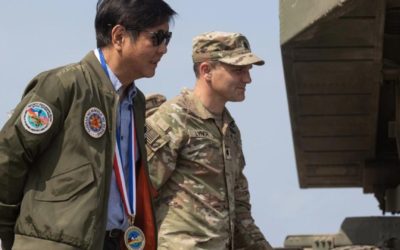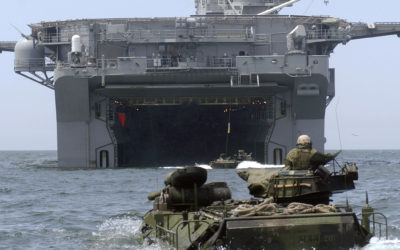On April 26, U.S. President Joe Biden welcomed South Korean President Yoon Suk-yeol to the White House for a summit meeting to celebrate the seventieth anniversary of the U.S.-South Korea alliance and open a new chapter for the next seventy years of expanded cooperation. Amid a substantial list of topics discussed by the two leaders, extended deterrence emerged as the top deliverable.
Compound Containment: A Reigning Power’s Military-Economic Countermeasures against a Challenging Power
Compound Containment: A Reigning Power’s Military-Economic Countermeasures against a Challenging Power
Compound Containment: A Reigning Power’s Military-Economic Countermeasures against a Challenging Power
When is a reigning great power of the international system in a position to complement military containment of a challenging power with restrictive economic measures? It has been long argued that a reigning power is inclined to militarily confront a challenging power that has the potential to undermine international stability and threaten the reigning state’s privileged relative power position. For many scholars, policy analysts, and practitioners of the reigning power’s strategy, containment—defined as the use of internal or external military balancing measures to stop the challenging power from launching military aggression—is a particularly attractive military option in dealing with the challenging power since it is less risky and costly than other strategies such as preventive war or rollback. 2 Nonetheless, since economic capacity and military power are intimately linked to one another, containing a challenging state requires addressing both economic and military dimensions. Indeed, after the United States became the reigning power, a country identified as an adversary of the United States encountered both military and economic countermeasures organized by Washington. Today, the United States is in a position to decide whether it should—or can— reinforce military containment of China with economic measures.
Scholars of great power competition, nonetheless, tend to focus on exam ining the reigning power’s military response alone.5 This situation is unfortu nate, because these scholars do not in fact assert that military force is the only consideration in containment strategy. On the contrary, most security studies scholars recognize that military measures should be supplemented by economic policies. Moreover, they agree that the reigning power’s security concerns over the challenging power are fundamentally motivated by changing distribution of material capacities, which reflects the two states’ differential economic growth.6 To put the point bluntly: scholars of great power politics agree that rapid economic growth endows the challenging power with an ability or incentive to revise the status quo, and, accordingly, responding to the challenging state requires addressing both military and economic aspects.
Despite this consensus, there have been only limited efforts to theorize the reigning power’s simultaneous employment of military and economic measures against the challenging power. The emphasis of the debate on economic instruments has been put on whether economic tools, as opposed to military force, can actually play an independent and effective role in advancing a state’s important strategic interests. Moreover, while debating the effectiveness of economic sanctions in international security affairs, many security studies scholars mistakenly dismiss altogether the roles of economic measures in great power relations. Although several scholars analyze the use of economic side payments within the context of great power competition, they often focus on the independent role of economic carrots and fall short of explaining or prescribing appropriate economic complements to diverse military strategies employed by the reigning power. In recent treatments of the interaction of economic relations and military outcomes, scholars offer insights to understand diverse economic aspects of great power competition. Yet the analytic focus of these studies has been explaining the conditions under which a great power maintains a peaceful relationship with another great power through commercial and financial linkages.
Overall, the economic aspects of containment strategy have not garnered appropriate academic attention, although scholars continue to engage with new strategies of checking a great power’s military aggression in the post–Cold War context. To be clear, this does not mean that scholars have not debated diverse strategic options available for a reigning power or that they lack knowledge about the economic dimension of great power competition. Yet, it still remains unclear whether and how the reigning power can complement military containment with economic measures. To be more accurate, the conceptual tools and theoretical insights that have been developed by the scholars of the intersection of security and economy deserve renewed attention to more effectively address the multilayered strategies of today’s great power competition.
This excerpt was republished under a Creative Commons license to point warfighters and national security professionals to reputable and relevant war studies literature. Read the original article here.

Dong Jung Kim is an Associate Professor in the College of International Studies and Graduate School of International Studies at Korea University.
Related Articles
President Marcos Jr. Meets With President Biden—But the U.S. Position in Southeast Asia is Increasingly Shaky
Over a four-day visit to Washington, Philippine President Ferdinand Marcos Jr. has been welcomed to the White House and generally feted across Washington. With President Biden, Marcos Jr. (whose father was forced out of office in part through U.S. pressure, and whose family has little love for the United States) affirmed that the two countries are facing new challenges, and Biden said that “I couldn’t think of a better partner to have than [Marcos Jr.].”
The U.S. is about to blow up a fake warship in the South China Sea—but naval rivalry with Beijing is very real and growing
As part of a joint military exercise with the Philippines, the U.S. Navy is slated to sink a mock warship on April 26, 2023, in the South China Sea.
The live-fire drill is not a response to increased tensions with China over Taiwan, both the U.S. and the Philippines have stressed. But, either way, Beijing isn’t happy – responding by holding its own staged military event involving actual warships and fighter jets deployed around Taiwan, a self-governed island that Beijing claims as its own.



